A spice grinder is a essential kitchen tool for freshly grinding spices, enhancing flavor and aroma․ Manual grinders offer precision and control, preserving spice fragrance without electricity․
1․1 What is a Spice Grinder?
A spice grinder is a kitchen tool designed to grind whole spices into powder․ Manual spice grinders, like the Kuhn Rikon, operate via a back-and-forth motion or rotating crank, offering precise control․ They are ideal for small quantities, preserving flavor and aroma without electricity․ Unlike electric grinders, manual versions are quieter, portable, and often easier to clean, making them a popular choice for home cooks seeking fresh, high-quality spice blends․
1․2 Benefits of Using a Spice Grinder
Using a spice grinder ensures fresher and more flavorful spices by grinding them just before use․ Manual grinders offer precise control over grind size, preserving the spice’s natural oils and aroma․ They are cost-effective, as whole spices last longer than pre-ground ones; Additionally, manual grinders are often easier to clean and maintain, making them a practical and efficient addition to any kitchen․ This method also allows for custom blending, enhancing culinary creativity and dish quality․
1․3 Manual vs․ Electric Spice Grinders
Manual spice grinders require manual effort, offering precise control and minimal noise, while electric grinders provide speed and convenience․ Manual grinders are cost-effective, easy to clean, and retain spice flavors better, but can be time-consuming․ Electric grinders are faster and ideal for large quantities but may generate heat, potentially altering spice flavors․ Choose based on your needs: manual for small batches and flavor preservation, electric for efficiency and ease of use․

Types of Manual Spice Grinders
Manual spice grinders come in three primary types: burr grinders, blade grinders, and mortar and pestle․ Each offers unique benefits for various spice grinding needs, preferences, and efficiency․
2․1 Burr Grinders
Burr grinders are a popular choice for manual spice grinding, offering precise control over grind size․ They feature two abrasive surfaces that crush spices consistently․ Unlike blade grinders, burr grinders reduce heat, preserving spice flavors․ Cleaning can be challenging, often requiring disassembly or specialized cleaners․ Despite this, their durability and ability to produce uniform grinds make them a favorite among culinary enthusiasts for achieving professional-quality results at home․ They are ideal for coarse or fine grinding, catering to various recipes and cooking methods․
2․2 Blade Grinders
Blade grinders are simple, manual devices that use a spinning blade to chop spices into smaller particles․ They are easy to use and clean, making them a convenient option for small quantities․ The blade’s motion allows for quick grinding, though it may generate heat, which can affect spice flavors․ Ideal for soft to medium-hard spices, blade grinders are versatile and suitable for everyday use, offering a practical solution for home cooks seeking freshly ground seasonings without complex setups․
2․3 Mortar and Pestle
A mortar and pestle is a traditional tool for grinding spices, offering exceptional control and precision․ It works by manually crushing spices against the mortar’s surface using the pestle․ This method ensures even particle distribution and preserves the spice’s aromatic oils․ Ideal for small batches, it allows for customizable texture, from coarse to fine․ While it requires more effort, the mortar and pestle delivers superior flavor and aroma, making it a timeless choice for spice enthusiasts seeking authenticity and quality․

How to Use a Manual Spice Grinder
Load the grinder with spices, adjust grind size, and turn the handle․ Follow tips for consistent results and optimal flavor preservation․ Ensure thorough cleaning afterward․
3․1 Loading the Grinder
To load the grinder, add spices through the front door or top opening․ Fill no more than one-third full for even grinding․ Secure the lid tightly to prevent spills․ Use whole spices or small herbs, ensuring they fit without overfilling․ This ensures efficient grinding and prevents clogging․ Proper loading is key to achieving the desired texture and flavor in your dishes․
3․2 Adjusting the Grind Size
Adjust the grind size by turning the handle or knob to achieve fine, medium, or coarse textures․ For burr grinders, rotate the adjustment ring at the base․ Blade grinders may require stopping to scrape down sides․ Mortar and pestle users can crush spices more or less․ Proper adjustment ensures optimal flavor release, making dishes more aromatic and balanced․ Experiment with settings to find your preferred consistency for each spice or herb․
3․3 Grinding Process
For manual grinders, turn the handle clockwise to grind spices․ Apply steady, firm pressure for burr grinders․ For mortar and pestle, pound and swirl spices with the pestle․ Blade grinders require short pulses to avoid overheating․ Continue until desired consistency is achieved․ Work in small batches for even results․ Clean between uses to prevent flavor transfer․ Regular grinding helps maintain blade sharpness and ensures optimal performance․ Patience and consistent motion yield the best outcomes for fresh, aromatic spices․
3․4 Tips for Effective Grinding
For optimal results, grind spices in small batches to ensure even consistency․ Freeze spices before grinding to prevent clumping․ Use short, pulsing motions for blade grinders to avoid overheating․ Clean the grinder after each use to preserve flavor integrity․ Store ground spices in airtight containers to maintain freshness․ Regularly sharpen or replace grinding surfaces to keep performance consistent․ Proper technique enhances both efficiency and the final quality of your ground spices․
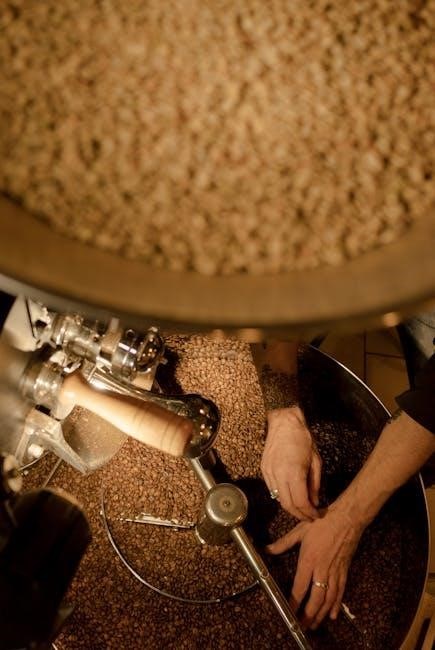
Cleaning and Maintenance
Cleaning and maintaining your manual spice grinder is essential for preserving flavor and functionality․ Regularly wipe down surfaces and remove residue to prevent spice buildup and contamination․
4․1 Cleaning After Use
Clean your manual spice grinder immediately after use to remove residue․ Use a soft brush or cloth to wipe down surfaces․ For stubborn particles, rinse with warm water and dry thoroughly․ Avoid harsh chemicals to prevent damage․ Regular cleaning ensures optimal performance and prevents flavor contamination․ Proper maintenance keeps your grinder in great condition for consistent spice grinding results․
4․2 Regular Maintenance
Regular maintenance ensures your manual spice grinder remains efficient․ After cleaning, dry all parts thoroughly to prevent rust․ Lubricate moving components periodically to maintain smooth operation․ Inspect for wear and tear, replacing worn-out parts as needed․ Sanitize occasionally with a mild vinegar solution to prevent mold․ Store in a dry place to avoid moisture buildup․ Proper care extends the grinder’s lifespan and ensures consistent grinding performance over time․
4․3 Storage Tips
Store your manual spice grinder in a cool, dry place to prevent moisture damage․ Use an airtight container or bag to keep it dust-free․ Avoid exposing the grinder to direct sunlight, as it may fade or warp materials․ For parts like the grinding mechanism, ensure they are completely dry before storage to prevent rust․ Keep the grinder away from children and pets․ Proper storage maintains its performance and longevity, ensuring it remains ready for future use․

Safety Precautions
Handle manual spice grinders with care, as blades and edges can be sharp․ Avoid overloading to prevent breakage․ Keep out of children’s reach for safety․
5․1 Handling Sharp Parts
When using a manual spice grinder, always handle sharp components with caution․ Blades and grinding mechanisms can cause injuries if not managed properly․ Ensure fingers are kept away from moving parts during operation․ After grinding, carefully clean sharp edges using a soft brush or cloth to avoid cuts․ Never touch the blades with bare hands, and store them securely to prevent accidents․ Proper handling ensures safety and longevity of the grinder․
5․2 Avoiding Overloading
Avoid overloading your manual spice grinder to ensure optimal performance and longevity․ Fill the chamber no more than halfway with spices to allow proper grinding motion․ Overloading can strain the mechanism, leading to difficulty in turning the handle or potential damage to the grinder․ Grind in small batches for consistent results and to maintain the efficiency of the device․ This practice prevents jams and ensures even particle distribution for the best flavor release․
5․3 Keeping Out of Reach of Children
Always keep your manual spice grinder out of children’s reach to prevent accidents․ Curious children may inadvertently injure themselves with sharp parts or create a mess․ Store the grinder in a high cabinet or secure location to avoid mishaps․ Ensure it is placed away from play areas and supervise children in the kitchen․ This precaution not only protects your child but also maintains the grinder’s condition and prevents unauthorized use․ Safety and responsibility go hand in hand when using kitchen tools․

Common Mistakes to Avoid
Common mistakes include overloading the grinder, using incorrect grind settings, and not cleaning properly․ These errors can lead to inconsistent results and reduced tool longevity․
6․1 Using Incorrect Grind Settings
Using the wrong grind setting is a common mistake that can result in uneven spice textures․ Fine grinds are ideal for baking, while coarser grinds suit rubs and marinades․ Adjusting the grinder correctly ensures optimal flavor release․ For example, blade grinders often pulverize spices too finely, losing aroma, while burr grinders offer precise control․ Always match the grind size to your recipe for the best culinary results and to avoid wasting spices․
6․2 Not Cleaning Properly
Not cleaning your manual spice grinder properly can lead to residual spices affecting the flavor of future grinds․ Old particles can mix with new spices, altering their taste․ Additionally, leftover residue can cause the grinder to jam or stick, reducing its efficiency over time․ Regular cleaning ensures optimal performance and prevents cross-contamination of flavors․ Use a soft brush or cloth to wipe down surfaces, and occasionally grind rice to absorb oils and odors from previous use․
6․3 Over-grinding Spices
Over-grinding spices is a common mistake that can lead to a loss of aromatic compounds and flavor․ When spices are ground too finely, they can become bitter and lose their natural oils, which are essential for enhancing dishes․ Additionally, over-grinding may introduce heat, which can damage delicate spices and alter their texture․ To avoid this, monitor the grinding process closely and stop once the desired consistency is achieved․
Using short bursts or pulse grinding can help prevent over-processing and preserve the spices’ integrity․ Always aim for the appropriate grind size based on the recipe requirements to ensure optimal flavor and aroma retention․
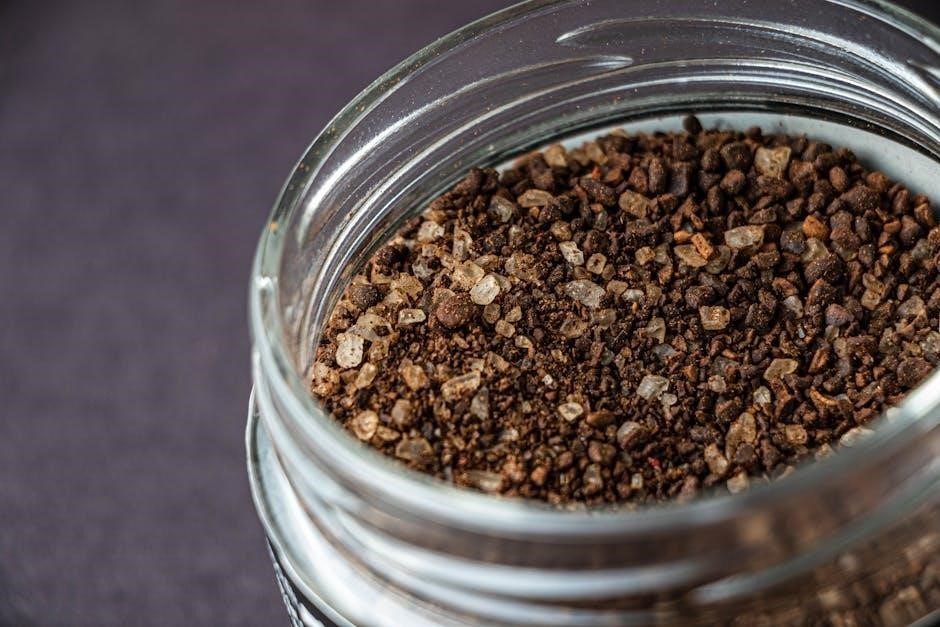
Troubleshooting Common Issues
Common issues with manual spice grinders include jamming, inconsistent grinds, or difficulty turning the handle․ Troubleshooting these problems ensures optimal performance and extends the grinder’s lifespan․
7․1 Jamming or Sticking
Jamming or sticking in manual spice grinders often occurs due to overloading or using oily spices․ To fix this, empty the grinder and brush out debris․ Grinding rice can absorb oil residue․ Avoid wet ingredients, as they cause sticking․ Regular cleaning prevents jams, ensuring smooth operation․ Always follow the manufacturer’s guidelines for spice quantity and type to avoid such issues․
7․2 Inconsistent Grind
An inconsistent grind can result from overloading the grinder or using the wrong spice type․ Ensure even particle size by not exceeding the recommended quantity․ Avoid oily or moist spices, as they may cling to parts․ Regularly clean the grinder and adjust grind settings firmly․ Using rice can help absorb oil residue․ Proper spice quantity and dryness are key for consistent results․ Follow these tips for uniform grinding performance every time․
7․3 Difficulty in Turning the Handle
Difficulty turning the handle often occurs due to overloading with hard spices like cinnamon or nuts․ Avoid using too much at once and process in small batches; Moisture or oil from spices can also cause sticking․ Regular maintenance, such as cleaning and drying, helps prevent this issue․ If the handle becomes hard to turn, stop immediately and empty excess spices before resuming․ Proper care ensures smooth operation and longevity of the grinder․
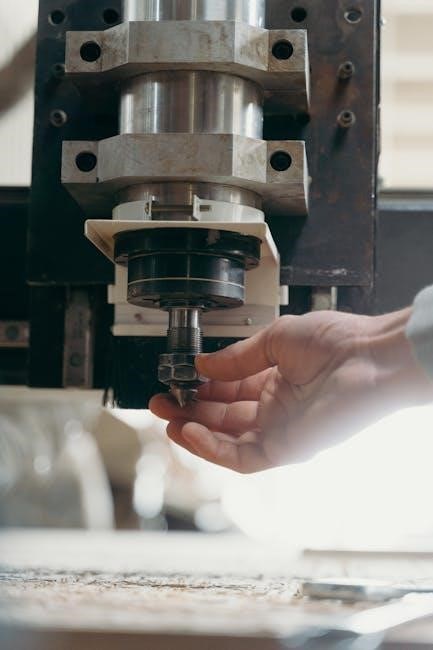
Advanced Tips for Optimal Grinding
Freeze spices beforehand to prevent oil release․ Use small batches for consistent results․ Clean thoroughly after each use to avoid flavor transfer․ Store ground spices in airtight containers․
8․1 Freezing Spices Before Grinding
Freezing spices before grinding helps maintain their aroma and flavor․ It prevents oils from releasing during grinding, keeping spices dry and easier to grind․ Simply place spices in an airtight bag and freeze for about 30 minutes․ This step is especially useful for fatty spices like cumin or coriander․ Frozen spices grind more evenly and retain their vibrancy, ensuring a fresher taste in your dishes․ Allow them to thaw slightly before grinding for optimal results․
8․2 Using the Right Spice Quantity
Using the right amount of spices ensures optimal grinding performance․ Overloading the grinder can lead to uneven results, while too few spices may not grind efficiently․ Fill the grinder about 2/3 full for best outcomes․ Adjust quantities based on spice density and desired output․ This balance ensures consistent flavor and prevents clogging․ Proper measurement enhances the manual grinder’s effectiveness, making the grinding process smoother and more efficient for achieving the perfect texture․ Always tailor the quantity to your recipe needs for superior results․
8․3 Grinding in Small Batches
Grinding in small batches ensures even particle distribution and prevents overheating, which can degrade spice flavors․ Small batches maintain aroma and texture, allowing for precise control over grind size․ This method is especially useful for delicate spices that lose potency quickly․ By grinding only what’s needed, you preserve freshness and avoid waste․ Refill the grinder as required, adjusting the grind size for consistent results․ Small batches enhance efficiency and flavor retention, making manual grinding more effective for home use․
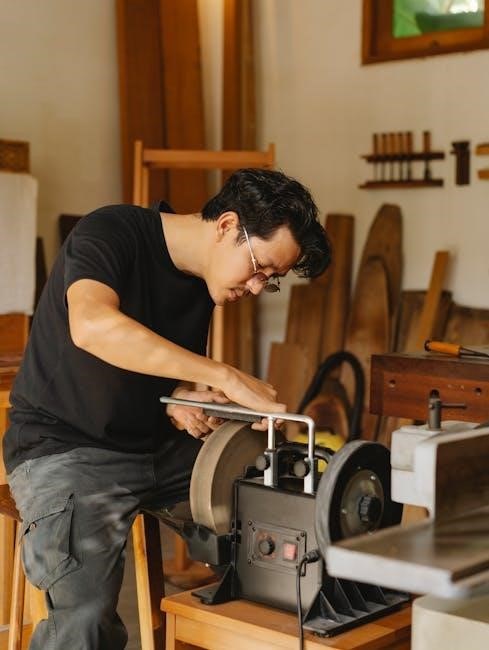
Storage and Organization of Ground Spices
Store ground spices in airtight containers to preserve freshness and aroma․ Label and date containers for easy identification․ Keep them in a cool, dark place to maintain flavor and potency․
9․1 Airtight Containers
Airtight containers are essential for maintaining the quality and aroma of ground spices․ They prevent exposure to moisture and air, which can cause spices to lose flavor and become rancid․ Glass or stainless steel containers are ideal as they are non-reactive and keep spices fresh․ Store them in a cool, dark place to protect from light and heat․ Label each container with the spice name and date for easy identification and organization․
9․2 Labeling and Dating
Proper labeling and dating ensure easy identification of ground spices․ Clearly write the spice name and date on each container using a permanent marker or adhesive labels․ This helps track freshness and prevents mix-ups․ Include the date format (e․g․, MM/YYYY) for clarity․ Consistent labeling maintains organization and makes meal preparation efficient․ Over time, this system helps ensure spices are used before losing their potency and aroma, keeping your pantry organized and functional․
9․3 Cool, Dark Storage
Storing ground spices in a cool, dark place preserves their flavor and aroma․ Light and heat can degrade spices quickly, so avoid placing containers near windows or ovens․ Ideal locations include pantry shelves or cupboard drawers․ Ensure the area is dry to prevent moisture exposure, which can cause clumping or spoilage․ Consistent cool and dark conditions maintain spice quality, ensuring optimal flavor when used in cooking․ This method extends shelf life and keeps spices fresh for longer periods․
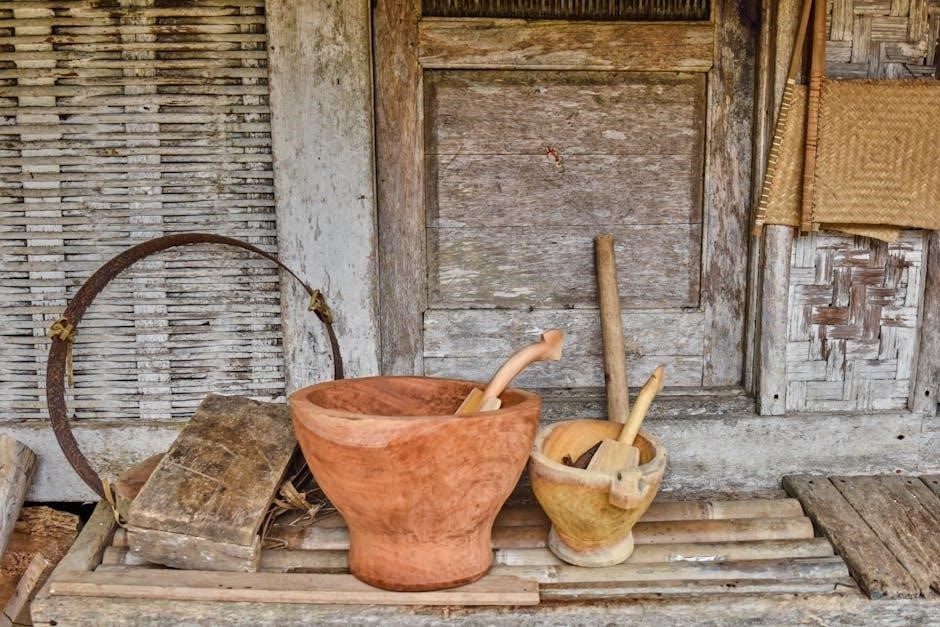
Comparison with Electric Grinders
Manual spice grinders offer precise control and flavor retention without electricity, while electric grinders provide speed and convenience, though they may lack the same level of control․
10․1 Speed and Convenience
Electric spice grinders offer unparalleled speed and convenience, quickly processing large quantities with minimal effort․ They are ideal for busy kitchens, requiring just the press of a button․ Unlike manual grinders, electric models handle tough spices effortlessly and save time, especially for bulk grinding․ However, they may lack the precision and control of manual grinders, making them less suitable for achieving fine, consistent textures․ The trade-off lies in convenience versus craftsmanship․
10․2 Noise Levels
Manual spice grinders are inherently quieter as they lack electric motors, making them ideal for noise-sensitive environments․ Electric grinders, while convenient, produce significant noise during operation due to their high-speed motors․ This can be a drawback in quiet kitchens or when grinding early in the morning․ The choice between the two often comes down to noise tolerance versus the need for speed and efficiency in food preparation․
10․4 Cost and Durability
Manual spice grinders are often more affordable and durable compared to electric models․ With fewer moving parts, they are less prone to mechanical failure, making them a cost-effective choice․ However, durability can vary based on construction materials; high-quality manual grinders may outlast electric ones․ Electric grinders, while more convenient, typically come at a higher cost and have more components that can wear out over time․ Manual grinders offer a long-lasting, budget-friendly alternative for consistent spice grinding․
Manual spice grinders offer a cost-effective, durable way to enhance flavor and aroma․ They provide precise control, making them a valuable tool for home cooks and chefs alike․
11․1 Final Thoughts
Manual spice grinders are a cost-effective, durable solution for enhancing flavor and aroma in cooking․ They allow for precise control over grind size and retain the natural fragrance of spices․ Cleaning and maintenance are straightforward, ensuring longevity․ By using fresh, hand-ground spices, home cooks and professional chefs can elevate their dishes to new heights․ Investing in a manual grinder is a simple yet impactful way to transform your culinary experience․